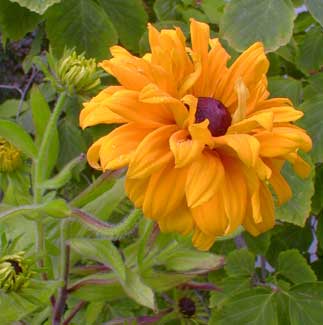
'Goldilocks'
Double Black-Eyed Susans
or Gloriosa Daisy
Though battle call me from thy arms
Let not my pretty Susan mourn;
Though cannons roar, yet safe from harms
William shall to his Dear return.
Love turns aside the balls that round me fly,
Lest precious tears should drop from Susan's eye.
from "Black-Eyed Susan"
by John Gay
(1685-1732)
by John Gay
(1685-1732)
Rudbeckia hirta 'Goldilocks' forms a clump that stands fourteen inches to two feet tall. The flowers are large mum-like doubles & semi-doubles in bright yellow, flowering from June or July until first frost or right into October, on long stems long-lasting for bouquets.
The species is a North American native wildflower variously known as Yellow Daisies, Yellow Coneflowers, Hairy Coneflowers, or offensively, Nigger Heads. The largest-flowering varieties are tetraploids called Gloriosa Daisies. The black "eye" or cone is not as obvious in a double-flowered rudbeckia. The cultivars are fairly drought hardy but will perform better with regular watering in sharply draining soil.
An biennial forb, if it is started from seed late in winter, it may bloom its first summer, or it may produce only leaves that first year. It's second summer it will for sure be powerfully flowery, then vanish from the garden that winter.
'Goldilocks' might self-seed but would do better if seeds were gathered & started in protected conditions. This Fleuroselect Bronze Medal winner is easily grown from seed, or can be obtained as small bedding plants usually offered as an annual since nurseries rarely have a biennial section.
 Gloriosa daisies with larger than normal blooms whether single or double are sometimes sold among perennials, for the Gloriosa types are a little more likely to last more than two years, especially if deadheaded before they go to seed.
Gloriosa daisies with larger than normal blooms whether single or double are sometimes sold among perennials, for the Gloriosa types are a little more likely to last more than two years, especially if deadheaded before they go to seed.'Goldilocks' & other Gloriosa types have twice the normal number of chromosomes, created by altering their DNA via radiation exposure or by being treated with the chemical colchicine. Once altered they pass their doubled chromosome traits to their own seedlings.
The genus has approxiately two-dozen species all native to North America, & named in honor of the Swedish botanist, rhetorician, antiquarian, astronomer, & professor of medicine at Upsala University, namely Olaus Rudbeck (1660-1740), shown in the portrait. As the leading anatomist of his day, Dr. Rudbeck was the discoverer of the lymphatic system.
Rudbeckia hirta is potentially toxic to cattle if great amounts of it were browsed. A tincture from the roots has been used as a traditional medicine similar to its close relative Echinacea.
Even though efficacy is improbable, it has been used to treat colds, injuries, snake bites, ear-aches, & intestinal worms. Modern research has not found it legitimately promising for anything beyond a faint possibility of the chemical components of Rudbeckias & Echinaceas possessing generalized non-specific immunostimulants & antioxidants.
Upon this uncertain possibility many a full-blown flimflam is foisted on the herb-swilling public, who lack easy access to the doubleblind studies which show that Echinacea, for example, has the exact effect on the common cold as do sugar-pills. But that doesn't keep the herbal companies from swearing up & down that you should keep them rolling in dough so you can use just such herbs to treat the very colds & lung complaints & allergies against which these remedies have no authentic power.
Continue to:
Rudbeckia x 'Goldquelle' Golden Fountain Coneflower